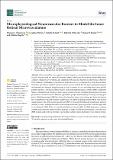Microphysiological Neurovascular Barriers to Model the Inner Retinal Microvasculature
Author(s)
Maurissen, Thomas L.; Pavlou, Georgios; Bichsel, Colette; Villaseñor, Roberto; Kamm, Roger D.; Ragelle, Héloïse; ... Show more Show less
Downloadjpm-12-00148.pdf (1.301Mb)
Publisher with Creative Commons License
Publisher with Creative Commons License
Creative Commons Attribution
Terms of use
Metadata
Show full item recordAbstract
Blood-neural barriers regulate nutrient supply to neuronal tissues and prevent neurotoxicity. In particular, the inner blood-retinal barrier (iBRB) and blood–brain barrier (BBB) share common origins in development, and similar morphology and function in adult tissue, while barrier breakdown and leakage of neurotoxic molecules can be accompanied by neurodegeneration. Therefore, pre-clinical research requires human in vitro models that elucidate pathophysiological mechanisms and support drug discovery, to add to animal in vivo modeling that poorly predict patient responses. Advanced cellular models such as microphysiological systems (MPS) recapitulate tissue organization and function in many organ-specific contexts, providing physiological relevance, potential for customization to different population groups, and scalability for drug screening purposes. While human-based MPS have been developed for tissues such as lung, gut, brain and tumors, few comprehensive models exist for ocular tissues and iBRB modeling. Recent BBB in vitro models using human cells of the neurovascular unit (NVU) showed physiological morphology and permeability values, and reproduced brain neurological disorder phenotypes that could be applicable to modeling the iBRB. Here, we describe similarities between iBRB and BBB properties, compare existing neurovascular barrier models, propose leverage of MPS-based strategies to develop new iBRB models, and explore potentials to personalize cellular inputs and improve pre-clinical testing.
Date issued
2022-01-24Department
Massachusetts Institute of Technology. Department of Biological Engineering; Massachusetts Institute of Technology. Department of Mechanical EngineeringJournal
Journal of Personalized Medicine
Publisher
MDPI AG
Citation
Maurissen TL, Pavlou G, Bichsel C, Villaseñor R, Kamm RD, Ragelle H. Microphysiological Neurovascular Barriers to Model the Inner Retinal Microvasculature. Journal of Personalized Medicine. 2022; 12(2):148
Version: Final published version
ISSN
2075-4426